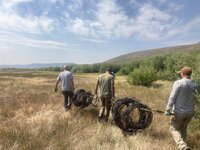What: Fence Removal at Rock Creek Ranch. SW of Hailey Idaho - Conducted by the new Wood River Chapter of MDF
When: Saturday July 13th-8AM
Where: Meet at the Rest Stop at Highway 20 and Highway 75 junction located South of Hailey, west of Picabo.
Why: Removing fence that obstructs ungulate migration in the Wood River valley. Fence location was Identified by IDFG as priority.
What to bring: Leather Gloves, Hat, Water, lunch, Sunglasses, rugged clothing, boots, fence pliers/wire cutters if you have them. We will have some extra gloves, and fencing pliers for volunteers if needed.
For questions PM me here on Rokslide, ANY help spreading the word is appreciated.
NOTE: I will be away from cell and internet from July 4th-10th so will be non-responsive to messages until July 10. The event is all-system's go and we are looking forward to your help completing some more on-the-ground work for migrating wildlife.
When: Saturday July 13th-8AM
Where: Meet at the Rest Stop at Highway 20 and Highway 75 junction located South of Hailey, west of Picabo.
Why: Removing fence that obstructs ungulate migration in the Wood River valley. Fence location was Identified by IDFG as priority.
What to bring: Leather Gloves, Hat, Water, lunch, Sunglasses, rugged clothing, boots, fence pliers/wire cutters if you have them. We will have some extra gloves, and fencing pliers for volunteers if needed.
For questions PM me here on Rokslide, ANY help spreading the word is appreciated.
NOTE: I will be away from cell and internet from July 4th-10th so will be non-responsive to messages until July 10. The event is all-system's go and we are looking forward to your help completing some more on-the-ground work for migrating wildlife.
Last edited:



